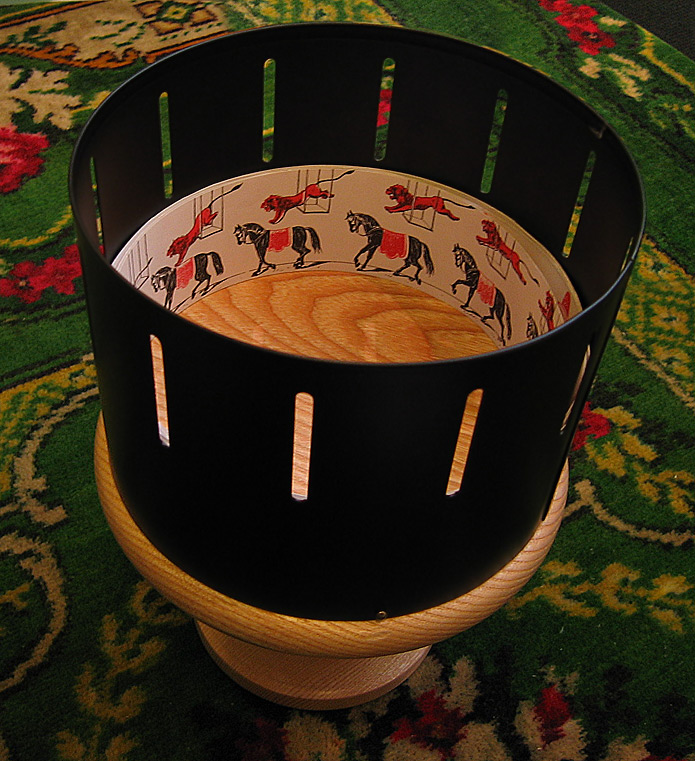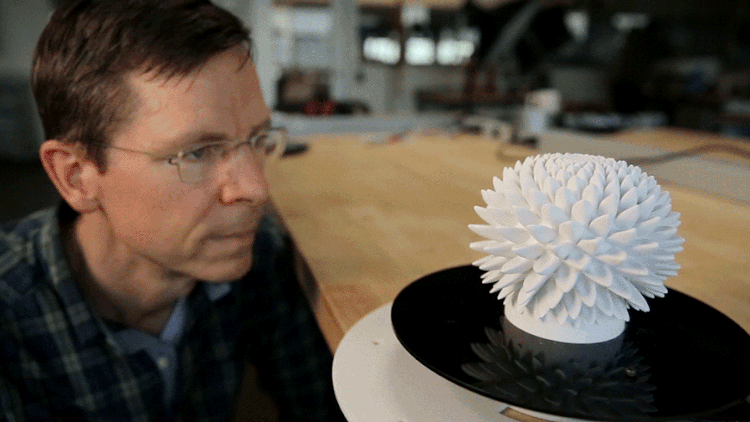Final project:¶
Zoetrope: Phi-Based Strobe Animated Sculptures
Introduction:¶
Zoetrope:¶
A zoetrope is one of several pre-film animation devices that produce the illusion of motion by displaying a sequence of drawings or photographs showing progressive phases of that motion.

A zoetrope is a device that produces the illusion of motion from a rapid succession of static pictures. The zoetrope consists of a cylinder with slits cut vertically in the sides. On the inner surface of the cylinder is a band with images from a set of sequenced pictures.

Inspiration¶
John Edmark’s Zoetrope (Blooms):¶
Blooms are 3D printed sculptures designed to animate when spun under a strobe light. Unlike a 3D zoetrope, which animates a sequence of small changes to objects, a bloom animates as a single self-contained sculpture. The bloom’s animation effect is achieved by progressive rotations of the golden ratio, phi (ϕ), the same ratio that nature employs to generate the spiral patterns we see in pinecones and sunflowers. The rotational speed and strobe rate of the bloom are synchronized so that one flash occurs every time the bloom turns 137.5º (the angular version of phi). Each bloom’s particular form and behavior is determined by a unique parametric seed I call a phi-nome (/fī nōm/).
Blooms: Strobe Animated Sculptures Invented by John Edmark from John Edmark on Vimeo.
Previous work from fablab:¶
Juliana Henno has work on it before, her idea of the 3D Zoetrope is that she could build a motorized platform that could be adjusted in relation of the blinking LED. The strobe effect generated by the blinking LEDs will cause an illusion of a camera shutter in which the flickering image(s) on the platform will give an idea of being in a constant motion without any breaks or intervals.
In order to amplify the contrast between darkness and light, the platform was projected to be enclosed inside of a container. This way, the light would be blocked from outside and the only brightness inside would be provided by the Strobe blinking effect.
Final Project from Juliana Henno on Vimeo.
Research:¶
John Edmark’s Blooms:¶
Phi-Based Strobe Animated Sculptures
See his instructable page for full details.
The rotation speed is carefully synchronized to the camera’s frame rate so that one frame of video is captured every time the bloom turns ~137.5º the golden angle. Each petal on the bloom is placed at a unique distance from the top-center of the form. If you follow what appears to be a single petal as it works its way out and down the bloom, what you are actually seeing is all the petals on the bloom in the order of their respective distances from the top-center. Read on to learn more about how these blooms were made, why the golden angle is such an important angle, and how these are related to the Fibonacci numbers. You will also find some tips for constructing the turntable and strobe light required to animate blooms.
He created a series of 3-D “Fibonacci zoetrope sculptures” that are designed to animate when spun under a strobe light. The placement of the appendages is determined by the same method nature uses in pinecones and sunflowers. The rotation speed is synchronized to the strobe so that one flash occurs every time the sculpture turns 137.5º—the golden angle. If you count the number of spirals on any of these sculptures you will find that they are always Fibonacci numbers. Each petal on the sculpture is placed at a unique distance from the top-center of the form. If you follow what appears to be a single petal as it works its way out and down the sculpture, what you are actually seeing is all the petals on the sculpture in the order of their respective distances from the top-center.
The illusions generated here are the result of a marriage between art and mathematics. Fibonacci’s Sequence is defined as a recurrent relationship that can be expressed as: F_n = F_{n-1} + F_{n-2} where the first two digits of the sequence can be defined as F_1=1, and F_2=1. What this means is that the sequence starts with two 1’s, and each following digit is determined by adding together the previous two. Therefore, Fibonacci’s Sequence begins: {1, 1, 2, 3, 5, 8, 13, 21, 34, 55, 89…} etc.

An Inconvenient Truth:¶
What you are viewing in each of the above videos is a bloom spinning at 550 RPMs while being videotaped at 24 frames-per-second with a very fast shutter speed (1/4000 sec). The rotation speed is carefully synchronized to the camera’s frame rate so that one frame of video is captured every time the bloom turns ~137.5º the golden angle…If you follow what appears to be a single petal as it works its way out and down the bloom, what you are actually seeing is all the petals on the bloom in the order of their respective distances from the top-center.
And now, here is a version with the white lies removed:
What you are viewing in each of the above videos is a bloom spinning at 340 RPMs while being videotaped at 24 frames-per-second with a very fast shutter speed (1/4000 sec). The rotation speed is carefully synchronized to the camera’s frame rate so that one frame of video is captured every time the bloom turns ~85º—not the golden angle…If you follow what appears to be a single petal as it works its way out and down the bloom, what you are actually seeing is every second petal on the bloom in the order of their respective distances from the top-center.
Why this particular speed, you ask? Well, if running it at the “proper” speed causes the camera to capture every petal of the bloom in sequential order, the next slower speed we could run it at while still achieving a consistent animation would be one that led to the camera capturing every second petal in sequential order. We know that it takes a rotation of 137.5º to get from any given petal to the next one in the sequence, so to skip a petal we need to rotate 2 * 137.5º, or 275º. Now, that may initially seem counterproductive, since we’ve doubled amount we have to rotate for each frame. But because we’re dealing with a circle, 275º is the same as -85º. So if we just reverse the direction the turntable is spinning, we can slow it down to 85º per frame and get an animation that moves twice as fast, because it only sequences half as many petals.
Of course, capturing every second petal is not the only speed change we can achieve. We could also choose to capture every third, every fourth, every fifth petal, and so on. Let’s look at how much we’d need to rotate the turntable for the first eight of these:

I have found the equation of Strobe Light + Sync from interactionstation: Zoetrope workshop
The Rotations per second x number of frames of animation = Frequency of the strobe or camera fps
Rotations per minute [RPM] = Rotations per second * 60
number of frames of animation = 360º / Resulting Angle
The speed is the unknown:
RPM = (Frequency / (number of frames of animation) * 60
What I want to add is Feedback:¶
I want to make a feedback loop to fine tune the speed of the motor [RPM], because the load that is mounted on the motor will affect the actual speed.



